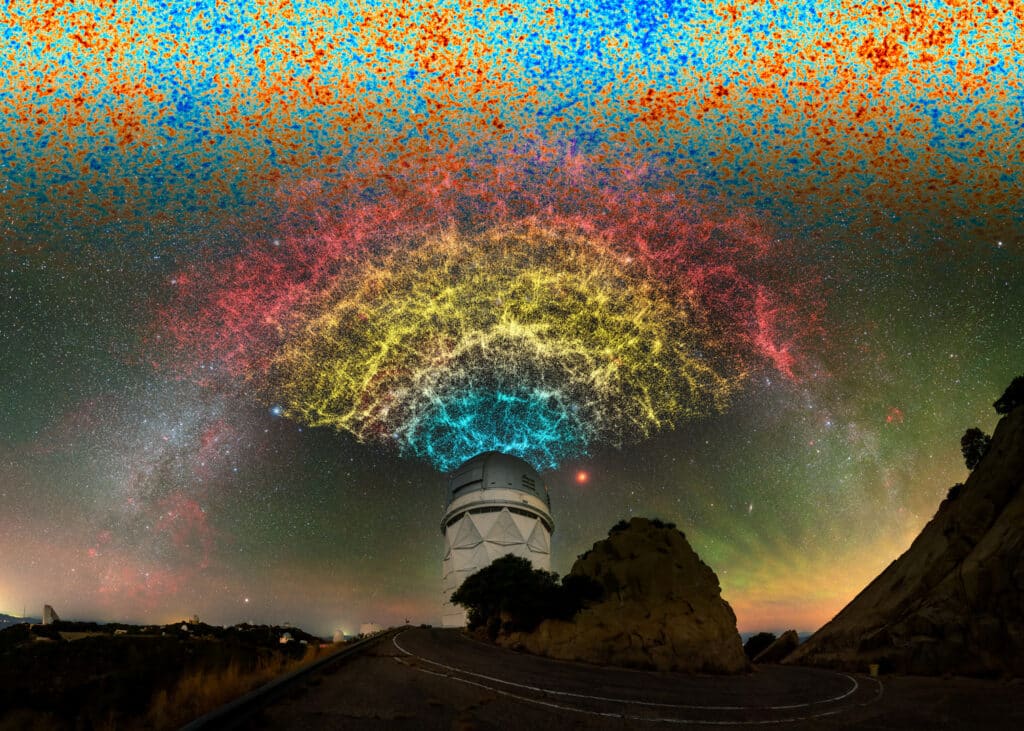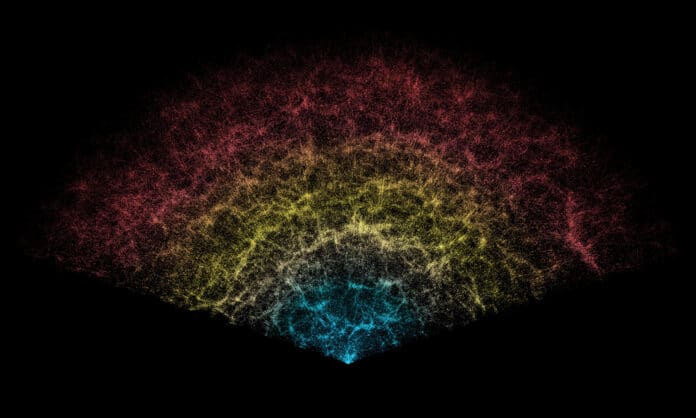Scientists have made a groundbreaking discovery about the nature of dark energy and its effect on the Universe’s large-scale structure. Using first-year data from the Dark Energy Spectroscopic Instrument Survey (DESI), unprecedented measurements of dark energy and its effect on the expanding Universe were reported.
DESI is conducting a five-year survey to create the most extensive 3D map of the Universe ever, with the goal of understanding the nature of dark energy and the mystery of why the Universe’s expansion is accelerating.
The DESI survey has observed a new set of 5000 galaxies every 20 minutes since its launch in 2021, totaling more than 100,000 galaxies per night. Using the survey’s first-year data, which contains the largest extragalactic spectroscopic sample ever collected, scientists have measured the Universe’s expansion history over the last 11 billion years with a precision better than 1%. These measurements confirm the basics of our best model of the Universe, while also uncovering some tantalizing areas to explore with more data.
DESI is an international science collaboration of more than 900 researchers from over 70 institutions worldwide, managed by the U.S. Department of Energy’s Lawrence Berkeley National Laboratory (LBNL) with primary funding from the Department’s Office of Science. The instrument is mounted on the U.S. National Science Foundation Nicholas U. Mayall 4-meter Telescope at Kitt Peak National Observatory.
To map the cosmos, DESI collects light from millions of galaxies across more than a third of the entire sky. By breaking down the light from each galaxy into its spectrum of colors, DESI can determine how much the light has been redshifted, or stretched to a longer wavelength, by the expansion of the Universe during the billions of years it traveled before reaching Earth. In general, the higher the redshift, the further away the galaxy is.

Equipped with 5000 tiny robotic ‘eyes,’ DESI is able to perform this measurement at an unprecedented rate. In its first year alone, DESI surpassed all previous surveys of its kind in terms of quantity and quality. With incredible depth and precision, DESI has brought new insight to one of the biggest mysteries in physics: dark energy — the unknown ingredient causing the expansion of our Universe to accelerate.
DESI’s first-year data have allowed scientists to measure the expansion rate of the Universe out to 11 billion years in the past, when the Universe was only a quarter of its current age, using a feature of the large-scale structure of the Universe called Baryon Acoustic Oscillations (BAO).
BAO are the leftover imprint of pressure waves that permeated the early Universe when it was nothing but a hot, dense soup of subatomic particles. As the Universe expanded and cooled, the waves stagnated, freezing the ripples in place and seeding future galaxies in the dense areas. This pattern, resembling the rippling surface of a pond after a handful of pebbles is tossed in, can be seen in DESI’s detailed map, which shows strands of galaxies clustered together, separated by voids where there are fewer objects.
The BAO pattern becomes too faint to detect at a certain distance using typical galaxies. So scientists look at the ‘shadow’ of the pattern as it’s backlit by extremely distant, bright galactic cores known as quasars. As the quasars’ light travels across the cosmos, it gets absorbed by intergalactic clouds of gas, allowing scientists to map the pockets of dense matter. To implement this technique, researchers used 450,000 quasars — the largest set ever collected for this type of study.
With DESI’s unique ability to map millions of objects both near and far, the BAO pattern can be used as a cosmic ruler. By mapping nearby galaxies and distant quasars, scientists can measure the spread of the ripples across several periods of cosmic history to see how dark energy has stretched the scale over time.
“We’re incredibly proud of the data, which have produced world-leading cosmology results,” said Michael Levi, DESI director and LBNL scientist. “So far, we’re seeing basic agreement with our best model of the Universe, but we’re also seeing some potentially interesting differences that could indicate dark energy is evolving with time. DESI’s quest to unravel the expansion history of the Universe has just begun, and we’re excited to see what we’ll learn next.”
